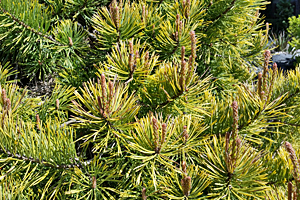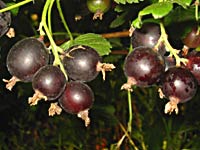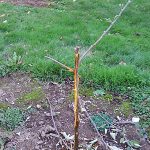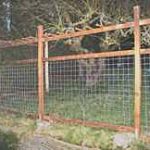Deer are a fact of life for many of us. They are charming to look at, but they can wreak havoc in the garden. Not only do they browse the plants, but the bucks will quickly destroy a plant when rubbing their antlers during the late summer and autumn rut. How can you garden in deer country?
Build a fence
The most effective way to garden in deer country is to fence the garden. Ask yourself these questions before fencing your garden-
- Do you need to fence the entire property, or can you just fence a garden area?
- Can you fence young plants temporarily, until they are big enough to withstand some deer damage?
- Are there constraints to fences, such as community regulations against certain types of fencing?
- Is building a fence worth the expense and time?
- Antler damage on young fruit tree
- 10′ Deer Fence
- Young orchard with mini-fences
If you decide to build a fence, make sure it is constructed properly. An effective deer fence needs to be at least 8′ high if using wire. A board fence that deer cannot see through needs to be at least 5 ½ ‘-6′ high. Also effective is a 4′ high, double fence, with 3′-4′ in between the fences. A deer will not jump this because there is not enough room between the fences for a safe landing. Electric fences of 8 wires spaced evenly up to 7’ also works, but takes more maintenance than a non-electric fence. Gates should be strongly constructed. For a drive through opening, two widths of cattle guard keep deer out as it is too wide to jump.
Mini-Fences
Fencing individual plants until they are large enough to tolerate some deer pressure is a common practice. Use 3-4 stakes around the tree to support the fence. It should be at least 5′ high. Black, polypropelene deer mesh works well for this. Make sure you can easily open the fence to do any plant maintenance required. Bird netting can also be draped over or around plants as a temporary barrier.
Repellents
Deer repellents work by coating the plants with a disagreeable odor or taste. Repellents need to be used before the deer have tasted a plant. They also need to be reapplied frequently, and work best if deer pressure is light. Deer can also become accustomed to the same repellent and begin to ignore it, so you may need to change formulas occasionally.
Homemade Deer Repellent
Mix the following in a 1 gallon tank sprayer:
- 2 beaten and strained eggs (straining keeps the eggs from clogging the sprayer)
- 1 cup milk, yogurt, buttermilk, or sour milk
- 2 tsp. Tabasco sauce or cayenne pepper
- 20 drops essential oil of clove, cinnamon, or eucalyptus
- 1 tsp. cooking oil or dormant (horticultural) oil
- 1 tsp. liquid dish soap
Top the tank with water. Shake frequently while spraying. Apply to dry foliage.
Will last 2-4 weeks in dry weather; reapply after rain.
Scare Tactics
Deer can be scared away using scarecrows, bright lights, radios, etc. Unfortunately, they can become accustomed to any tactic used over a period of time. Moving the scare objects frequently can work. One recent innovation is a sprinkler activated by a motion sensor. This also needs to be moved frequently to keep the deer from becoming too accustomed to it.
Dogs are effective at keeping deer out of your yard, if they are in the yard and are active. Using an electric “invisible” fence to keep the dog in the yard is the most effective method.
Planting “Deer Resistant” Plants

Golden Scots Pine
There are many lists of “Deer Resistant” plants out there; unfortunately, deer don’t read. In areas of severe deer pressure, the deer will eat anything. In areas of light to moderate deer pressure, they may taste these plants, but usually will not eat them to the ground. No plant is resistant to the antler rubbing damage.
In general, plants with aromatic foliage, like lavender, rosemary and sage, or slightly stinky foliage like Mexican Mock Orange – Choisya ternata– and Pacific Wax Myrtle- Myrica californica– are not attractive to deer. Deer tend to leave many conifers alone, especially those with needle-like foliage, including firs, hemlocks and pines. Plants with sharp thorns or prickly leaves are usually left alone, including most barberry and Mahonia.

Black currant
In fruiting plants, black currants and figs are generally not tasty to deer- almost all other fruit plants need to be protected. Fuzzy kiwi vines are also not commonly browsed, and grapes are usually left alone if deer pressure is not too high. Most fruit trees must be fenced to avoid browsing.





We do not have any deer problem at Bellingham Country Gardens! DOGS. Yes we have two friendly farm dogs who live happily outside at our farm. Their presence and their scent seems to be the answer, because they do not have to actually chase the deer.
Please consider making our U-Pick, No Spray garden your summer garden for all of your vegetable needs and Everbearing Strawberries. Learn more at bellinghamcountrygardens.com and updates on facebook (Bellingham Country Gardens).